![]()
![]()
![]()
Use LEFT and RIGHT arrow keys to navigate between flashcards;
Use UP and DOWN arrow keys to flip the card;
H to show hint;
A reads text to speech;
33 Cards in this Set
- Front
- Back
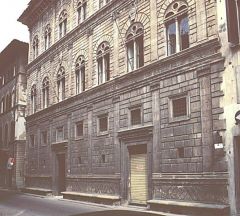
|
Alberti, The Rucellai Palace, 1452-70, Renaissance
-three levels -columns articulated engaged in all three levels -cohesive sense to where windows and doors should be -rectangular forms -columns frame it all together |
|
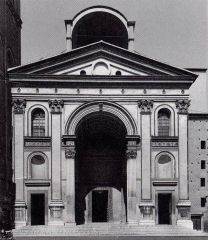
|
Alberti, Sant’Andrea, 1470, Renaissance
-bring all the classical elements together -broken up into different levels with a cohesive whole of the arch side doors and very distinct clear parts -same shape on the inside as on the outside -clear articulation of parts -not mysterious and cluttered like the gothic |
|
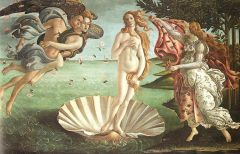
|
Botticelli, The Birth of Venus, c. 1480s, Renaissance
-Neo-Platonism -intertwining of secular and sacred -Mary is the ideal -Mary is shown as Venus -she is the perfect woman -Venus Putica -commissioned by the Medici family possibly for a wedding -supposed to be a lesson for the bride |
|
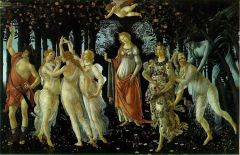
|
Botticelli Primavera, 1480s, Renaissance
- a sort of Mandola - rebirth etc - allegorical figures |
|

|
Botticelli, Venus and Mars, 1480’s, Renaissance
-fairly sensual -suggestive drapery -he is clearly dreaming -reason over brute nature - |
|
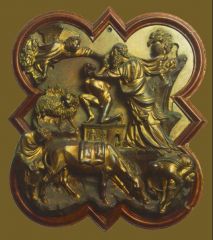
|
Sacrifice of Isaac, 1401-2, Italian 15th century Renaissance, Brunelleschi
-pedestal recalls the aria pacis -puts the spinario in the bottom right -quatrafoil -each figure on its own -drapery not as real -Ghiberti wins and makes the doors |
|
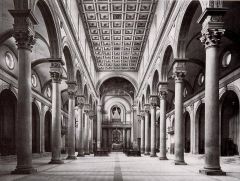
|
Brunelleschi, Santo Spirito, begun 1436, early renaissance Italy
-Corinthian columns -very classical -flat topped nave -corbelled detailing -takes proportions from perspective and applies to architecture -all based on proportion and math |
|
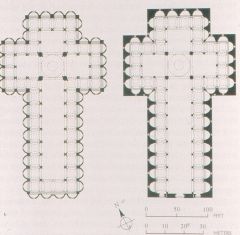
|
Brunelleschi, Santo Spirito, begun 1436, early
-takes proportions from perspective and applies to architecture -bases the whole structure off of one module unit -nave is twice as tall as the side isles -all based on proportion and math |
|
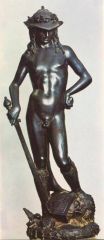
|
Donatello, David, 1428-32, Renaissance (move towards to secular)
-was in the medici palace -first life-sized nude since antiquity |
|
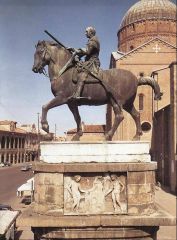
|
Donatello, Gattamelata, 1445-50, Renaissance
-a condotiary -equestrian portrait as used in rome to exalt a great leader |
|

|
Donatello, Mary Magdalene, 1450s, Renaissance
-she was a sinner -she changes her ways -she goes off and lives in the woods -clothing is made out of her hair -medium is glazed wood |
|

|
Donatelo, S. George, 1415-17 , Italian Renaissance C.15th
-amour maker’s guild -off balance, contraposto -youthful, idealized -see the musculature -scene on the predella has st. George slaying the dragon -conventions are relaxed -perspective used on the archway in the predella |
|
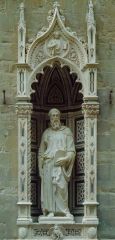
|
Donatello, S. Mark, 1411-3, Donatello, Italian Renaissance C.15th
-for the linen making guild -elaborate background |
|
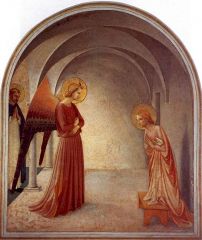
|
Fra Angelico, The Annunciation and the Transfiguration. 1440-45, Italian renaissance 15thC.
-frescos in his monastery -St. Marco Monastery in Florence -Dominican monk in the back -while the monk was praying he was in the presence of angel etc -painting mimics actual architecture of monastery -almost like an icon |
|
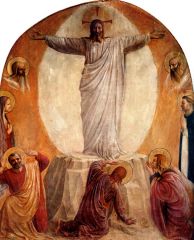
|
Fra Angelico, The Annunciation and the Transfiguration. 1440-45, Italian renaissance 15thC.
-frescos in his monastery -St. Marco Monastery in Florence -Dominican monk in the back -while the monk was praying he was in the presence of angel etc -painting mimics actual architecture of monastery -almost like an icon |
|
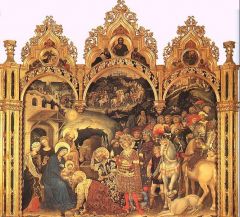
|
Gentile Da Fabriano, Adoration of the Magi, 1432, Renaissance 15th Century
-reminiscent of international gothic style with the framing and gold -decorative drapery -small details in the vignettes from the Sienese Rennaisance. -altarpiece -predella scenes -succinct narratives -different stories around the beginning of jesus’s life - not filled, more space to breathe |
|

|
Sacrifice of Isaac, 1401-2, Italian 15th century Renaissance, Ghiberti
-made for contest in Florence for doors of the baptistery -right across from the duomo -pannel had to fit in a quatrafoil had to depict the sacrifice of Isaac -had to pull from classical art -Classical elements --> ara pacis reference -drapery use looks classical -idealized musculature, classic looking proportions -contraposto -shows depth a lot better with slanting cliff |
|
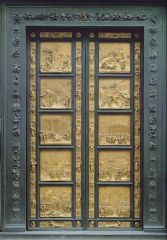
|
Bapistry north doors, 1405, Italian 15th century, Renaissance, Ghiberti
-thinking about perspective, but based on observation -not REAL perspective yet -after competition -one point perspective |
|
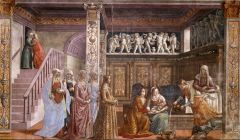
|
Ghirandario, Birth of the Virgin, 1485-90, Renaissance
-golden age of Florence -much more secular stuff going on -the elite begin to establish themselves -teacher of Michelangelo -scene takes place in a palace -reminiscent of ornate 3rd Pompeii style -Patron is standing with her hands on tummy in the sacred space -interest in classicism -shown as rich, liking arts and interested in classcicsim |
|
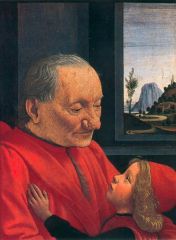
|
Ghirlandario, Old man and young boy, 1480, Renaissance
-Dude has weird nose, Veristic depiction -made in memory of the grandfather -show the love and gentility of the grandfather -shows a landscape scene in the back to show depth etc. |
|
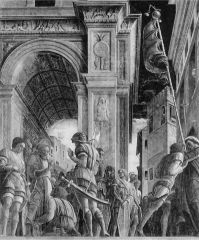
|
Andrea Mantegna, St. James Led to his Martyrdom, 1455 renaissance
-on the way to James’s death he stops to bless another -perspective is as if we are on the ground looking up -puts the viewer in the same position as the dude being blessed - |
|
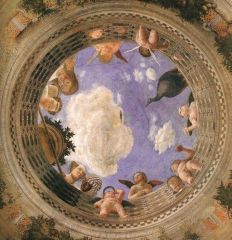
|
Mantegna, Ceiling of the Ducale Palace, 1474, renaissance
-playing with prospective -trombloy -fools the eye to look like you are actually looking up -everyone is peering over -unstable and playful -emphasizes perspective - in the duke’s palace SECULAR SETTING |
|
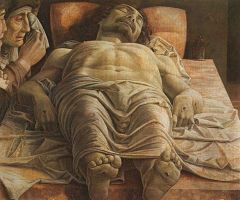
|
Mantegna, Dead Christ, 1501, Renaissance
-we are immediately confronted with his feet and the wounds on his feet -exaggerated perspective to emphasize his wounds |
|
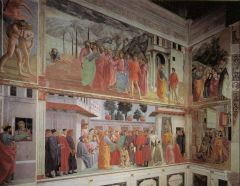
|
Masaccio, Brancacci Chapel, 1425
-Adam is in internal and eve is exterior -conveyed through gesture -reminiscent of Giotto -hills in the background leading us into the composition -tribute narrative -three parts of the narrative in one scene continuous, or sequential narrative -weighty figures -orthogonal lead to Jesus -light coincides with the light in the chapel itself -comes from Giotto |
|
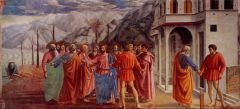
|
Tribute Money, Masaccio, 1425
sequential narrative sculptural influences Blue sky=Giotto light source aligned with windows in chapel |
|
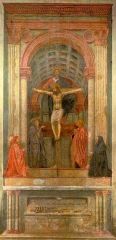
|
Masaccio, Trinity, 1425, Italian Renaissance,
-vanishing point is at Jesus feet/eye level -momento mori at the bottom -pray |
|

|
Expulsion from the Garden of Eden, Masaccio, 1425
gesture=giotto emotional shape of adam and physical shame of eden |
|
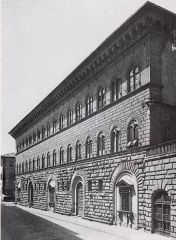
|
Michelozzo, Medici Palace, 1450’s Renaissance
-three levels are from the colloseum -interior has columns and small round vignettes -blocky and private on the outside and more ornamented on the inside -Architect read Vitruvius’s treatise -Rustication |
|
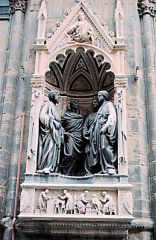
|
Nanni di Banco, Four Saints, 1408-14
-for the stone workers guild -on the orsanmichele -predella – bottom panel -predella has stone workers -figures are classical because they are contraposto, S curve -the four stand together, they interact -drapery makes them classical -each is pretty distinct in their faces -saints from the roman times |
|

|
Peter keys
|
|
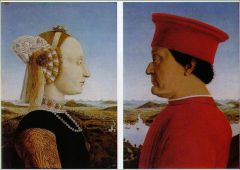
|
Duke and Duchess of Urbino, Piero Della Francesca, 1455-60
-on the back there are matching horses with wagons -both pulled by unicorns -symmetrical -allegories for values |
|
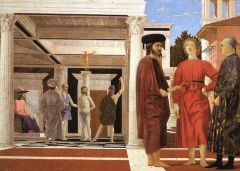
|
Pierro della Francesca, the Flagellation of Christ, 1455-60
Renaissance -very interested in math -proportion -black strip on top bracci is used as unit of measurement—similar to Brunelleschi -firm upright cylindrical figures -clear shapes for the heads -inspires artists |
|
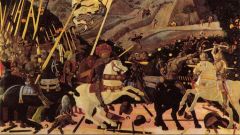
|
Uccello , The Battle of San Romano, 1450s, Middle – transition from early to middle renaissance
-painted for Medicis, seen in the oranges -focus on the vanishing point -mercenary (condotiary) in the middle (famous dude) |

